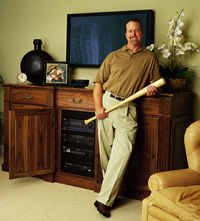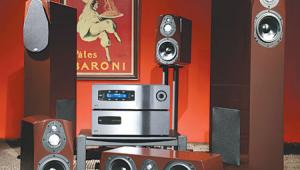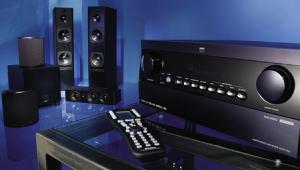A Home Theater Humdinger
Few Americans can forget the images of September 8, 1998, when St. Louis Cardinals first baseman Mark McGwire slammed the magic number 62 homer that made him Major League Baseball's single-season home-run record breaker. Now retired from baseball, McGwire spends his well-earned time off with his family, golfing, and of course enjoying his wholehouse entertainment system. In 1997, McGwire teamed up with home entertainment integrator Sean S. Fields, president of Audio/Video Entertainment, and they've been on a winning streak ever since.
 "I was introduced to Mark through another professional baseball player, retired Angels pitcher Mike Witt," says Fields. "Mike was a client of mine at the time, and he recommended AVE, providing me the golden opportunity to show how good the integrator/client relationship can be when the partnership is based on honesty and mutual respect. As a result, Mark has used AVE for his home entertainment needs ever since."
"I was introduced to Mark through another professional baseball player, retired Angels pitcher Mike Witt," says Fields. "Mike was a client of mine at the time, and he recommended AVE, providing me the golden opportunity to show how good the integrator/client relationship can be when the partnership is based on honesty and mutual respect. As a result, Mark has used AVE for his home entertainment needs ever since."
Back in '97, McGwire was a prolific laserdisc collector (remember those things?). The first system that AVE installed for McGwire was based around a high-performance laserdisc player. A video-distribution device sent its signal throughout the house. The laserdisc player's output went to various televisions, but the main display device was a front projector, which shot onto a motorized 100-inch Stewart screen. According to Fields, "The projectors back then were huge and cumbersome compared with the size they are today. The biggest challenge with that first job was that the projector had to be built into an antique gypsy cart made of fossilized wood. That projector installation was a bit nerve-racking, but I had, and still have, the best installation team in the world, and they pulled off that tricky bit of customization without a hitch." The installation challenges didn't stop there. Fields adds: "The 100-inch motorized movie screen dropped from a custom-designed soffit that was built above the fireplace. One of Mark's objectives was that the screen be completely out of view when it's not in use. Working with Mark's designer, Shawna Milner of CMC Interiors (Long Beach, California), made this project enjoyable and, ultimately, successful." McGwire was pleased with the results, in terms of both performance and aesthetics.
"Being the magnanimous person he is," continues Fields, "Mark allowed us to show his system to new clients as an example of what was possible. That was a pretty trick system back in 1997, and we got a lot of future business from showing it. Most celebrities would have balked at the idea of letting strangers into their home, but Mark is not like your typical celebrity. He's a class act."
Fast-forward to 2003. "[Mark's] not particularly interested in the products, but rather that the end result meets his needs," asserts Fields. "However, he did have a few requests when it came to this system. He wanted a large-screen plasma in the family room, and he specified DirecTV with TiVo. He also wanted to be able to access the TiVo from any TV in the home."
So, gone is the laser-disc player and the huge LCD projector, replaced with a more-elegant, up-to-date system based around a 50-inch Pioneer Elite plasma, a DirecTV/TiVo unit, and Sony progressive-scan DVD players. For audio, AVE chose SpeakerCraft AIM Series in-ceiling speakers and a Triad in-wall subwoofer. For wholehouse audio, AVE used SpeakerCraft CRS-4 in-ceiling speakers, strategically located throughout the home so that every appropriate space is bathed in high-quality music.
While the gypsy cart has long since wheeled off into oblivion, this project presented its own unique battery of challenges. Among the hurdles, AVE was integrating the A/V system into a production home, with the accompanying rigid, breakneck-speed schedules. Fortunately for everyone involved, integrating home entertainment into production homes is AVE's forte. They conduct nearly 80 percent of their business through production builders.
Another challenge that the AVE design and engineering teams faced was the fact that this home would be McGwire's temporary domicile as his custom home was being designed and built. So Fields and crew had the additional task of designing a system that would be, for all intents and purposes, temporary. "Knowing this home was not Mark's final destination," says Fields, "we created a system that was high-quality but didn't go overboard price-wise. But also, we knew he'd want to keep some of the components, like the plasma and main equipment cabinet. We had to design a system that looked permanent but was actually moveable." Such a design flies in the face of the inherent concept of contemporary home entertainment integration, which dictates that the system be part of the home. "If Mark had planned on staying in this house for a long time, we would've approached the design quite differently. The equipment would've been integrated into a custom, built-in cabinet, designed specifically for the specified electronics." Had AVE done so, however, McGwire would have been obligated to leave the equipment behind as part of the home.
- Log in or register to post comments























































